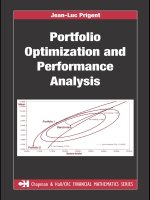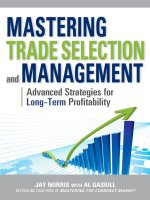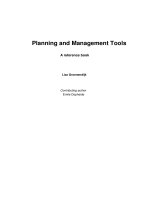Robust portfolio optimization and management
Bạn đang xem bản rút gọn của tài liệu. Xem và tải ngay bản đầy đủ của tài liệu tại đây (6.53 MB, 513 trang )
ffirs.frm Page iii Tuesday, April 10, 2007 10:54 AM
Robust Portfolio
Optimization and
Management
FRANK J. FABOZZI
PETTER N. KOLM
DESSISLAVA A. PACHAMANOVA
SERGIO M. FOCARDI
John Wiley & Sons, Inc.
ffirs.frm Page vi Tuesday, April 10, 2007 10:54 AM
ffirs.frm Page i Tuesday, April 10, 2007 10:54 AM
Robust Portfolio
Optimization and
Management
ffirs.frm Page vi Tuesday, April 10, 2007 10:54 AM
ffirs.frm Page iii Tuesday, April 10, 2007 10:54 AM
Robust Portfolio
Optimization and
Management
FRANK J. FABOZZI
PETTER N. KOLM
DESSISLAVA A. PACHAMANOVA
SERGIO M. FOCARDI
John Wiley & Sons, Inc.
ffirs.frm Page ii Tuesday, April 10, 2007 10:54 AM
THE FRANK J. FABOZZI SERIES
Fixed Income Securities, Second Edition by Frank J. Fabozzi
Focus on Value: A Corporate and Investor Guide to Wealth Creation by James L. Grant and
James A. Abate
Handbook of Global Fixed Income Calculations by Dragomir Krgin
Managing a Corporate Bond Portfolio by Leland E. Crabbe and Frank J. Fabozzi
Real Options and Option-Embedded Securities by William T. Moore
Capital Budgeting: Theory and Practice by Pamela P. Peterson and Frank J. Fabozzi
The Exchange-Traded Funds Manual by Gary L. Gastineau
Professional Perspectives on Fixed Income Portfolio Management, Volume 3 edited by
Frank J. Fabozzi
Investing in Emerging Fixed Income Markets edited by Frank J. Fabozzi and Efstathia Pilarinu
Handbook of Alternative Assets by Mark J. P. Anson
The Global Money Markets by Frank J. Fabozzi, Steven V. Mann, and Moorad Choudhry
The Handbook of Financial Instruments edited by Frank J. Fabozzi
Collateralized Debt Obligations: Structures and Analysis by Laurie S. Goodman and
Frank J. Fabozzi
Interest Rate, Term Structure, and Valuation Modeling edited by Frank J. Fabozzi
Investment Performance Measurement by Bruce J. Feibel
The Handbook of Equity Style Management edited by T. Daniel Coggin and Frank J. Fabozzi
The Theory and Practice of Investment Management edited by Frank J. Fabozzi and
Harry M. Markowitz
Foundations of Economic Value Added: Second Edition by James L. Grant
Financial Management and Analysis: Second Edition by Frank J. Fabozzi and Pamela P. Peterson
Measuring and Controlling Interest Rate and Credit Risk: Second Edition by Frank J. Fabozzi,
Steven V. Mann, and Moorad Choudhry
Professional Perspectives on Fixed Income Portfolio Management, Volume 4 edited by
Frank J. Fabozzi
The Handbook of European Fixed Income Securities edited by Frank J. Fabozzi and
Moorad Choudhry
The Handbook of European Structured Financial Products edited by Frank J. Fabozzi and
Moorad Choudhry
The Mathematics of Financial Modeling and Investment Management by Sergio M. Focardi
and Frank J. Fabozzi
Short Selling: Strategies, Risks, and Rewards edited by Frank J. Fabozzi
The Real Estate Investment Handbook by G. Timothy Haight and Daniel Singer
Market Neutral Strategies edited by Bruce I. Jacobs and Kenneth N. Levy
Securities Finance: Securities Lending and Repurchase Agreements edited by Frank J. Fabozzi
and Steven V. Mann
Fat-Tailed and Skewed Asset Return Distributions by Svetlozar T. Rachev, Christian Menn,
and Frank J. Fabozzi
Financial Modeling of the Equity Market: From CAPM to Cointegration by Frank J.
Fabozzi, Sergio M. Focardi, and Petter N. Kolm
Advanced Bond Portfolio Management: Best Practices in Modeling and Strategies edited by
Frank J. Fabozzi, Lionel Martellini, and Philippe Priaulet
Analysis of Financial Statements, Second Edition by Pamela P. Peterson and Frank J. Fabozzi
Collateralized Debt Obligations: Structures and Analysis, Second Edition by Douglas J.
Lucas, Laurie S. Goodman, and Frank J. Fabozzi
Handbook of Alternative Assets, Second Edition by Mark J. P. Anson
Introduction to Structured Finance by Frank J. Fabozzi, Henry A. Davis, and Moorad Choudhry
Financial Econometrics by Svetlozar T. Rachev, Stefan Mittnik, Frank J. Fabozzi,
Sergio M. Focardi, and Teo Jasic
Developments in Collateralized Debt Obligations: New Products and Insights by Douglas J.
Lucas, Laurie S. Goodman, Frank J. Fabozzi, and Rebecca J. Manning
ffirs.frm Page iv Tuesday, April 10, 2007 10:54 AM
Copyright © 2007 by John Wiley & Sons, Inc. All rights reserved.
Published by John Wiley & Sons, Inc., Hoboken, New Jersey.
Published simultaneously in Canada.
Wiley Bicentennial Logo: Richard J. Pacifico
No part of this publication may be reproduced, stored in a retrieval system, or transmitted in
any form or by any means, electronic, mechanical, photocopying, recording, scanning, or otherwise, except as permitted under Section 107 or 108 of the 1976 United States Copyright
Act, without either the prior written permission of the Publisher, or authorization through
payment of the appropriate per-copy fee to the Copyright Clearance Center, Inc., 222 Rosewood Drive, Danvers, MA 01923, (978) 750-8400, fax (978) 646-8600, or on the web at
www.copyright.com. Requests to the Publisher for permission should be addressed to the Permissions Department, John Wiley & Sons, Inc., 111 River Street, Hoboken, NJ 07030, (201)
748-6011, fax (201) 748-6008, or online at />Limit of Liability/Disclaimer of Warranty: While the publisher and author have used their best
efforts in preparing this book, they make no representations or warranties with respect to the
accuracy or completeness of the contents of this book and specifically disclaim any implied
warranties of merchantability or fitness for a particular purpose. No warranty may be created
or extended by sales representatives or written sales materials. The advice and strategies contained herein may not be suitable for your situation. You should consult with a professional
where appropriate. Neither the publisher nor author shall be liable for any loss of profit or
any other commercial damages, including but not limited to special, incidental, consequential,
or other damages.
For general information on our other products and services or for technical support, please
contact our Customer Care Department within the United States at (800) 762-2974, outside
the United States at (317) 572-3993, or fax (317) 572-4002.
Wiley also publishes its books in a variety of electronic formats. Some content that appears in
print may not be available in electronic books. For more information about Wiley products,
visit our web site at www.wiley.com.
ISBN: 978-0-471-92122-6
Printed in the United States of America.
10 9 8 7 6 5 4 3 2 1
ffirs.frm Page v Tuesday, April 10, 2007 10:54 AM
FJF
To my wife Donna and my children,
Francesco, Patricia, and Karly
PNK
To Åke and Gunilla, my parents, and to John and Carmen,
my wife’s parents, for their unending love and support
DAP
To my husband, Christian Hicks,
and in memory of my grandfather, Georgyi Milyankov
SMF
To the memory of Bertrand Russell to whom I owe
the foundation of my intellectual development
ftoc.frm Page vii Tuesday, April 10, 2007 10:56 AM
Contents
Preface
About the Authors
xi
xv
CHAPTER 1
Introduction
Quantitative Techniques in the Investment Management Industry
Central Themes of This Book
Overview of This Book
1
1
9
12
PART ONE
Portfolio Allocation: Classical Theory and Extensions
CHAPTER 2
Mean-Variance Analysis and Modern Portfolio Theory
The Benefits of Diversification
Mean-Variance Analysis: Overview
Classical Framework for Mean-Variance Optimization
The Capital Market Line
Selection of the Optimal Portfolio When There Is a Risk-Free Asset
More on Utility Functions: A General Framework for Portfolio Choice
Summary
CHAPTER 3
Advances in the Theory of Portfolio Risk Measures
Dispersion and Downside Measures
Portfolio Selection with Higher Moments through Expansions of Utility
Polynomial Goal Programming for Portfolio
Optimization with Higher Moments
Some Remarks on the Estimation of Higher Moments
The Approach of Malevergne and Sornette
Summary
15
17
18
21
24
35
41
45
50
53
54
70
78
80
81
86
vii
ftoc.frm Page viii Tuesday, April 10, 2007 10:56 AM
viii
CONTENTS
CHAPTER 4
Portfolio Selection in Practice
Portfolio Constraints Commonly Used in Practice
Incorporating Transaction Costs in Asset-Allocation Models
Multiaccount Optimization
Summary
87
88
101
106
111
PART TWO
Robust Parameter Estimation
113
CHAPTER 5
Classical Asset Pricing
Definitions
Theoretical and Econometric Models
Random Walk Models
General Equilibrium Theories
Capital Asset Pricing Model (CAPM)
Arbitrage Pricing Theory (APT)
Summary
115
115
117
118
131
132
136
137
CHAPTER 6
Forecasting Expected Return and Risk
Dividend Discount and Residual Income Valuation Models
The Sample Mean and Covariance Estimators
Random Matrices
Arbitrage Pricing Theory and Factor Models
Factor Models in Practice
Other Approaches to Volatility Estimation
Application to Investment Strategies and Proprietary Trading
Summary
139
140
146
157
160
168
172
176
177
CHAPTER 7
Robust Estimation
The Intuition behind Robust Statistics
Robust Statistics
Robust Estimators of Regressions
Confidence Intervals
Summary
179
179
181
192
200
206
ftoc.frm Page ix Tuesday, April 10, 2007 10:56 AM
Contents
CHAPTER 8
Robust Frameworks for Estimation: Shrinkage,
Bayesian Approaches, and the Black-Litterman Model
Practical Problems Encountered in Mean-Variance Optimization
Shrinkage Estimation
Bayesian Approaches
Summary
ix
207
208
215
229
253
PART THREE
Optimization Techniques
255
CHAPTER 9
Mathematical and Numerical Optimization
Mathematical Programming
Necessary Conditions for Optimality for Continuous
Optimization Problems
Optimization Duality Theory
How Do Optimization Algorithms Work?
Summary
267
269
272
288
CHAPTER 10
Optimization under Uncertainty
Stochastic Programming
Dynamic Programming
Robust Optimization
Summary
291
293
308
312
332
CHAPTER 11
Implementing and Solving Optimization Problems in Practice
Optimization Software
Practical Considerations When Using Optimization Software
Implementation Examples
Specialized Software for Optimization Under Uncertainty
Summary
333
333
340
346
358
360
257
258
ftoc.frm Page x Tuesday, April 10, 2007 10:56 AM
x
CONTENTS
PART FOUR
Robust Portfolio Optimization
361
CHAPTER 12
Robust Modeling of Uncertain Parameters in Classical
Mean-Variance Portfolio Optimization
Portfolio Resampling Techniques
Robust Portfolio Allocation
Some Practical Remarks on Robust Portfolio Allocation Models
Summary
363
364
367
392
393
CHAPTER 13
The Practice of Robust Portfolio Management: Recent Trends and
New Directions
Some Issues in Robust Asset Allocation
Portfolio Rebalancing
Understanding and Modeling Transaction Costs
Rebalancing Using an Optimizer
Summary
395
396
410
413
422
435
CHAPTER 14
Quantitative Investment Management Today and Tomorrow
Using Derivatives in Portfolio Management
Currency Management
Benchmarks
Quantitative Return-Forecasting Techniques and Model-Based
Trading Strategies
Trade Execution and Algorithmic Trading
Summary
447
456
460
APPENDIX A
Data Description: The MSCI World Index
463
INDEX
473
439
440
442
445
fpref.frm Page xi Tuesday, April 10, 2007 10:59 AM
Preface
n the past few years, there has been a notable increase in the use of
financial modeling and optimization tools in equity portfolio management. In addition to the pressure on asset management firms to reduce
costs and maintain a more stable and predictable performance in the
aftermath of the downturn in the U.S. equity markets in 2002, three other
general trends have contributed to this increase. First, there has been a
revived interest in predictive models for asset returns. Predictive models
assume that it is possible to make conditional forecasts of future
returns—an objective that was previously considered not achievable by
classical financial theory. Second, the wide availability of sophisticated
and specialized software packages has enabled generating and exploiting
these forecasts in portfolio management, often in combination with optimization and simulation techniques. Third, the continuous increase in
computer speed and the simultaneous decrease in hardware costs have
made the necessary computing power affordable even to small firms.
As the use of modeling techniques has become widespread among
portfolio managers, however, the issue of how much confidence practitioners can have in theoretical models and data has grown in importance. Consequently, there is an increased level of interest in the subject
of robust estimation and optimization in modern portfolio management. For years, robustness has been a crucial ingredient in the engineering, statistics, and operations research fields. Today, these fields
provide a rich source of ideas to finance professionals. While robust
portfolio management undoubtedly demands much more than the
robust application of quantitative techniques, there is now a widespread
recognition for the need of a disciplined approach to the analysis and
management of investments.
In this book we bring together concepts from finance, economic theory, robust statistics, econometrics, and robust optimization, and illustrate
that they are part of the same theoretical and practical environment—in a
way that even a nonspecialized audience can understand and appreciate.
At the same time, we emphasize a practical treatment of the subject, and
translate complex concepts into real-world applications for robust return
I
xi
fpref.frm Page xii Tuesday, April 10, 2007 10:59 AM
xii
PREFACE
forecasting and asset allocation optimization. Thereby, we address a number of issues in portfolio allocation and rebalancing. In particular, we discuss how to make portfolio management robust with respect to model risk,
long-term views of the market, and market frictions such as trading costs.
The book is divided into four parts. Part I covers classical portfolio
theory and its modern extensions. We provide an up-to-date treatment of
methods for advanced risk management, nonnormal distributions for
asset returns, transaction costs, and multiaccount portfolio management.
Part II introduces traditional and modern frameworks for robust estimation of returns. We address a number of topics that include dimensionality reduction, robust covariance matrix estimation, shrinkage estimators,
and the Black-Litterman framework for incorporating investors’ views in
an equilibrium framework. Part III provides readers with the necessary
background for handling the optimization part of portfolio management.
It covers major issues in numerical optimization, introduces widely used
optimization software packages and modeling platforms, and discusses
methods for handling uncertainty in optimization models such as stochastic programming, dynamic programming, and robust optimization.
Part IV focuses on applications of the robust estimation and optimization
methods described in the previous parts, and outlines recent trends and
new directions in robust portfolio management and in the investment
management industry in general. We cover a range of topics from portfolio resampling, robust formulations of the classical portfolio optimization framework under modeling uncertainty, robust use of factor models,
and multiperiod portfolio allocation models—to the use of derivatives in
portfolio management, currency management, benchmark selection,
modern quantitative trading strategies, model risk mitigation, as well as
optimal execution and algorithmic trading.
We believe that practitioners and analysts who have to develop and
use portfolio management applications will find these themes—along
with the numerous examples of applications and sample computer
code—useful. At the same time, we address the topics in this book in a
theoretically rigorous way, and provide references to the original works,
so the book should be of interest to academics, students, and researchers who need an updated and integrated view of the theory and practice
of portfolio management.
TEACHING USING THIS BOOK
This book can be used in teaching courses in advanced econometrics,
financial engineering, quantitative investments and portfolio manage-
fpref.frm Page xiii Tuesday, April 10, 2007 10:59 AM
Preface
xiii
ment, as the main course book, as supplemental reading on advanced topics, and/or for student projects. The material in Chapters 2 through 11 of
the book is appropriate for undergraduate advanced electives on investment management, and all topics in the book are accessible to graduate
students in finance, economics or in the mathematical and physical sciences. The material is also appropriate for use in advanced graduate electives in the decision sciences and operations research that focus on
applications of quantitative techniques in finance.
For a typical course, it is natural to start with Chapters 2, 5, and 6
where modern portfolio and asset pricing theory and standard estimation techniques are covered. Basic practical considerations are presented
in Chapters 4 and 11. Chapters 3, 7, 8, 10, 12, and 13 are more
advanced and do not have to be covered in full. A possibility is to focus
on the most common techniques used in portfolio management today,
such as Value-at-Risk (VaR) and Conditional Value-at-Risk (CVaR) (in
Chapter 3), shrinkage estimators and the Black-Litterman model (in
Chapter 8), robust optimization (in Chapters 10 and 12), and transaction costs and portfolio rebalancing (in Chapter 13). Student projects
can be based on specialized topics such as multiaccount optimization (in
Chapter 4), numerical optimization techniques (in Chapter 9), modern
trading strategies, optimal execution, and algorithmic trading (in Chapter 14).
ACKNOWLEDGMENTS
In writing a book that covers a wide range of topics in portfolio management theory and practice, applied mathematics, statistics, and operations
research, we were fortunate to have received valuable comments and suggestions from the following individuals (listed below in alphabetical order):
■ Sebastian Ceria and Robert Stubbs of Axioma, Inc. reviewed Chapter
■
■
■
■
■
■
■
12.
Eranda Dragoti-Cela of Siemens—Fin4Cast reviewed Chapter 12.
Dashan Huang of Kyoto University reviewed Chapters 10, 12, and 13.
Ivana Ljubic of the University of Vienna reviewed Chapter 12.
John M. Manoyan of CYMALEX Advisors reviewed Chapter 14.
Jeff Miller of Millennium Partners reviewed Chapters 13 and 14.
Bernd Scherer of Morgan Stanley reviewed Chapter 4.
Melvyn Sim of the National University of Singapore Business School
reviewed Chapter 12.
fpref.frm Page xiv Tuesday, April 10, 2007 10:59 AM
xiv
PREFACE
■ Reha Tütüncü of Goldman Sachs Asset Management reviewed Chap-
ters 10 and 12.
We thank Morgan Stanley Capital International, Inc., http://
www.msci.com, for providing us with the MSCI World Index data set
used in some of the computational examples throughout the book. In
particular, we are indebted to Nicholas G. Keyes for answering all of
our questions in regards to the data set.
Megan Orem typeset the book and provided editorial assistance. We
appreciate her patience and understanding in working through numerous revisions of the chapters and several reorganizations of the table of
contents.
Frank J. Fabozzi
Petter N. Kolm
Dessislava A. Pachamanova
Sergio M. Focardi
flast.frm Page xv Tuesday, April 10, 2007 11:00 AM
About the Authors
Frank J. Fabozzi is Professor in the Practice of Finance in the School of
Management at Yale University. Prior to joining the Yale faculty, he was a
Visiting Professor of Finance in the Sloan School at MIT. Frank is a Fellow of the International Center for Finance at Yale University and on the
Advisory Council for the Department of Operations Research and Financial Engineering at Princeton University. He is the editor of the Journal of
Portfolio Management and an associate editor of the Journal of Fixed
Income. He earned a doctorate in economics from the City University of
New York in 1972. In 2002 was inducted into the Fixed Income Analysts
Society’s Hall of Fame and is the 2007 recipient of the C. Stewart Sheppard Award given by the CFA Institute. He earned the designation of
Chartered Financial Analyst and Certified Public Accountant. He has
authored and edited numerous books in finance.
Petter N. Kolm is a doctoral student in Finance at the School of Management, Yale University, a financial consultant in New York City, and a
member of the editorial board of the Journal of Portfolio Management.
Previously, he worked in the Quantitative Strategies Group at Goldman
Sachs Asset Management where his responsibilities included researching
and developing new quantitative investment strategies for the group’s
hedge fund. Petter coauthored the books Financial Modeling of the
Equity Market: From CAPM to Cointegration and Trends in Quantitative
Finance. His research interests include various topics in finance, such as
equity and fixed income modeling, delegated portfolio management,
financial econometrics, risk management, and optimal portfolio strategies. Petter received a doctorate in mathematics from Yale University in
2000. He also holds an M.Phil. in applied mathematics from the Royal
Institute of Technology in Stockholm and an M.S. in mathematics from
ETH Zürich.
Dessislava A. Pachamanova is an Assistant Professor of Operations
Research at Babson College where she holds the Zwerling Term Chair.
Her research interests lie in the areas of robust optimization, portfolio
xv
flast.frm Page xvi Tuesday, April 10, 2007 11:00 AM
xvi
ABOUT THE AUTHORS
risk management, simulation, and financial engineering. Dessislava’s academic research is supplemented by consulting and previous work in the
financial industry, including projects with quantitative strategy groups at
WestLB and Goldman Sachs. She holds an A.B. in Mathematics from
Princeton University and a Ph.D. in Operations Research from the Sloan
School of Management at MIT.
Sergio Focardi is a founding partner of the Paris-based consulting firm
The Intertek Group and consults and trains on quantitative methods in
equity portfolio management. Sergio is a member of the Editorial Board
of the Journal of Portfolio Management, co-author of the CFA Institute’s
monograph Trends in Quantitative Finance (Fabozzi, Focardi and Kolm,
2006) of the books Financial Econometrics (Rachev, Mittnik, Fabozzi,
Focardi, Jasic, Wiley, 2007), Financial Modeling of the Equity Market
(Fabozzi, Focardi and Kolm, Wiley, 2006), The Mathematics of Financial
Modeling and Investment Management (Focardi and Fabozzi, Wiley,
2004), Risk Management: Framework, Methods and Practice (Focardi
and Jonas, Wiley, 1998), and Modeling the Markets: New Theories and
Techniques (Focardi and Jonas, Wiley, 1997). Sergio has implemented
long-short equity portfolio selection applications based on dynamic factor
analysis. His research interests include the econometrics of large equity
portfolios and the modeling of regime changes. Sergio holds a degree in
Electronic Engineering from the University of Genoa and a postgraduate
degree in Communications from the Galileo Ferraris Electrotechnical
Institute (Turin).
ch1-Intro Page 1 Tuesday, March 6, 2007 12:07 PM
CHAPTER
1
Introduction
s the use of quantitative techniques has become more widespread in
the financial industry, the issues of how to apply financial models
most effectively and how to mitigate model and estimation errors have
grown in importance. This book discusses some of the major trends and
innovations in the management of financial portfolios today, focusing
on state-of-the-art robust methodologies for portfolio risk and return
estimation, optimization, trading, and general management.
In this chapter, we give an overview of the main topics in the book.
We begin by providing a historical outlook of the adoption of quantitative techniques in the financial industry and the factors that have contributed to its growth. We then discuss the central themes of the book in
more detail, and give a description of the structure and content of its
remaining chapters.
A
QUANTITATIVE TECHNIQUES IN THE INVESTMENT
MANAGEMENT INDUSTRY
Over the last 20 years there has been a tremendous increase in the use of
quantitative techniques in the investment management industry. The
first applications were in risk management, with models measuring the
risk exposure to different sources of risk. Nowadays, quantitative models are considered to be invaluable in all the major areas of investment
management, and the list of applications continues to grow: option pricing models for the valuation of complicated derivatives and structured
products, econometric techniques for forecasting market returns, automated execution algorithms for efficient trading and transaction cost
management, portfolio optimization for asset allocation and financial
1
ch1-Intro Page 2 Tuesday, March 6, 2007 12:07 PM
2
ROBUST PORTFOLIO OPTIMIZATION AND MANAGEMENT
planning, and statistical techniques for performance measurement and
attribution, to name a few.
Today, quantitative finance has evolved into its own discipline—an
example thereof is the many university programs and courses being
offered in the area in parallel to the “more traditional” finance and
MBA programs. Naturally, many different factors have contributed to
the tremendous development of the quantitative areas of finance, and it
is impossible to list them all. However, the following influences and contributions are especially noteworthy:
■ The development of modern financial economics, and the advances in
the mathematical and physical sciences.
■ The remarkable expansion in computer technology and the invention
of the Internet.
■ The maturing and growth of the capital markets.
Below, we highlight a few topics from each one of these areas and discuss their impact upon quantitative finance and investment management
in general.
Modern Financial Economics and the Mathematical and
Physical Sciences
The concepts of portfolio optimization and diversification have been
instrumental in the development and understanding of financial markets
and financial decision making. The major breakthrough came in 1952
with the publication of Harry Markowitz’s theory of portfolio selection.1 The theory, popularly referred to as modern portfolio theory, provided an answer to the fundamental question: How should an investor
allocate funds among the possible investment choices? Markowitz suggested that investors should consider risk and return together and determine the allocation of funds among investment alternatives on the basis
of the trade-off between them. Before Markowitz’s seminal article, the
finance literature had treated the interplay between risk and return in a
casual manner.
The idea that sound financial decision making is a quantitative
trade-off between risk and return was revolutionary for two reasons.
First, it posited that one could make a quantitative evaluation of risk
1
Harry M. Markowitz, “Portfolio Selection,” Journal of Finance 7, no. 1 (March
1952), pp. 77–91. The principles in Markowitz’s article were later expanded upon
in his book Portfolio Selection, Cowles Foundation Monograph 16 (New York: John
Wiley & Sons, 1959). Markowitz was awarded the Nobel Prize in Economic Sciences
in 1990 for his work.
ch1-Intro Page 3 Tuesday, March 6, 2007 12:07 PM
Introduction
3
and return jointly by considering portfolio returns and their comovements. An important principle at work here is that of portfolio diversification. It is based on the idea that a portfolio’s riskiness depends on the
covariances of its constituents, not only on the average riskiness of its
separate holdings. This concept was foreign to classical financial analysis, which revolved around the notion of the value of single investments,
that is, the belief that investors should invest in those assets that offer
the highest future value given their current price. Second, it formulated
the financial decision-making process as an optimization problem. In particular, the so-called mean-variance principle formulated by Markowitz
suggests that among the infinite number of portfolios that achieve a particular return objective, the investor should choose the portfolio that
has the smallest variance. All other portfolios are “inefficient” because
they have a higher variance and, therefore, higher risk.
Building on Markowitz’s work, William Sharpe,2 John Lintner,3 and
Jan Mossin4 introduced the first asset pricing theory, the capital asset
pricing model—CAPM in short—between 1962 and 1964. The CAPM
became the foundation and the standard on which risk-adjusted performance of professional portfolio managers is measured.
Modern portfolio theory and diversification provide a theoretical
justification for mutual funds and index funds, that have experienced a
tremendous growth since the 1980s. A simple classification of fund
management is into active and passive management, based upon the efficient market hypotheses introduced by Eugene Fama5 and Paul Samuelson6 in 1965. The efficient market hypothesis implies that it is not
possible to outperform the market consistently on a risk-adjusted basis
after accounting for transaction costs by using available information. In
active management, it is assumed that markets are not fully efficient and
that a fund manager can outperform a market index by using specific
information, knowledge, and experience. Passive management, in con2
William F. Sharpe, “Capital Asset Prices,” Journal of Finance 19, no. 3 (September
1964), pp. 425–442. Sharpe received the Nobel Prize in Economic Sciences in 1990
for his work.
3
John Lintner, “The Valuation of Risk Assets and the Selection of Risky Investments
in Stock Portfolio and Capital Budgets,” Review of Economics and Statistics 47
(February 1965), pp. 13–37.
4
Jan Mossin, “Equilibrium in a Capital Asset Market,” Econometrica 34, no. 4 (October 1966), pp. 768–783.
5
Eugene F. Fama, “The Behavior of Stock Market Prices,” Journal of Business 38
(January 1965), pp. 34–105.
6
Paul A. Samuelson, “Proof that Properly Anticipated Prices Fluctuate Randomly,”
Industrial Management Review 6, no. 2 (Spring 1965), pp. 41–49. Samuelson was
honored with the Nobel Prize in Economic Sciences in 1970.
ch1-Intro Page 4 Tuesday, March 6, 2007 12:07 PM
4
ROBUST PORTFOLIO OPTIMIZATION AND MANAGEMENT
trast, relies on the assumption that financial markets are efficient and
that return and risk are fully reflected in asset prices. In this case, an
investor should invest in a portfolio that mimics the market. John Bogle
used this basic idea when he proposed to the board of directors of the
newly formed Vanguard Group to create the first index fund in 1975.
The goal was not to outperform the S&P 500 index, but instead to track
the index as closely as possible by buying each of the stocks in the S&P
500 in amounts equal to the weights in the index itself.
Despite the great influence and theoretical impact of modern portfolio theory, today—more than 50 years after Markowitz’s seminal
work—full risk-return optimization at the asset level is primarily done
only at the more quantitatively oriented firms. In the investment management business at large, portfolio management is frequently a purely
judgmental process based on qualitative, not quantitative, assessments.
The availability of quantitative tools is not the issue—today’s optimization technology is mature and much more user-friendly than it was at
the time Markowitz first proposed the theory of portfolio selection—yet
many asset managers avoid using the quantitative portfolio allocation
framework altogether.
A major reason for the reluctance of investment managers to apply
quantitative risk-return optimization is that they have observed that it
may be unreliable in practice. Specifically, risk-return optimization is
very sensitive to changes in the inputs (in the case of mean-variance optimization, such inputs include the expected return of each asset and the
asset covariances). While it can be difficult to make accurate estimates of
these inputs, estimation errors in the forecasts significantly impact the
resulting portfolio weights. It is well-known, for instance, that in practical applications equally weighted portfolios often outperform mean-variance portfolios, mean-variance portfolios are not necessarily welldiversified, and mean-variance optimization can produce extreme or
non-intuitive weights for some of the assets in the portfolio. Such examples, however, are not necessarily a sign that the theory of risk-return
optimization is flawed; rather, that when used in practice, the classical
framework has to be modified in order to achieve reliability, stability,
and robustness with respect to model and estimation errors.
It goes without saying that advances in the mathematical and physical sciences have had a major impact upon finance. In particular, mathematical areas such as probability theory, statistics, econometrics,
operations research, and mathematical analysis have provided the necessary tools and discipline for the development of modern financial economics. Substantial advances in the areas of robust estimation and
robust optimization were made during the 1990s, and have proven to be
ch1-Intro Page 5 Tuesday, March 6, 2007 12:07 PM
Introduction
5
of great importance for the practical applicability and reliability of portfolio management and optimization.
Any statistical estimate is subject to error—estimation error. A robust
estimator is a statistical estimation technique that is less sensitive to outliers
in the data. For example, in practice, it is undesirable that one or a few
extreme returns have a large impact on the estimation of the average return
of a stock. Nowadays, Bayesian techniques and robust statistics are commonplace in financial applications. Taking it one step further, practitioners
are starting to incorporate the uncertainty introduced by estimation errors
directly into the optimization process. This is very different from the classical approach, where one solves the portfolio optimization problem as a
problem with deterministic inputs, without taking the estimation errors
into account. In particular, the statistical precision of individual estimates is
explicitly incorporated in the portfolio allocation process. Providing this
benefit is the underlying goal of robust portfolio optimization.
First introduced by El Ghaoui and Lebret7 and by Ben-Tal and
Nemirovski,8 modern robust optimization techniques allow a portfolio
manager to solve the robust version of the portfolio optimization problem in about the same time as needed for the classical portfolio optimization problem. The robust approach explicitly uses the distribution
from the estimation process to find a robust portfolio in one single optimization, thereby directly incorporating uncertainty about inputs in the
optimization process. As a result, robust portfolios are less sensitive to
estimation errors than other portfolios, and often perform better than
classical mean–variance portfolios. Moreover, the robust optimization
framework offers great flexibility and many new interesting applications. For instance, robust portfolio optimization can exploit the notion
of statistically equivalent portfolios. This concept is important in largescale portfolio management involving many complex constraints such as
transaction costs, turnover, or market impact. Specifically, with robust
optimization, a manager can find the best portfolio that (1) minimizes
trading costs with respect to the current holdings and (2) has an
expected portfolio return and variance that are statistically equivalent
to those of the classical mean-variance portfolio.
An important area of quantitative finance is that of modeling asset
price behavior, and pricing options and other derivatives. This field can
7
Laurent El Ghaoui, and Herve Lebret, “Robust Solutions to Least-Squares Problems with Uncertain Data,” SIAM Journal on Matrix Analysis and Applications 18
(October 1997), pp. 1035–1064.
8
Aharon Ben-Tal, and Arkadi S. Nemirovski, “Robust Convex Optimization,”
Mathematics of Operations Research 23, no. 4 (1998), pp. 769–805; and Aharon
Ben-Tal, and Arkadi S. Nemirovski, “Robust Solutions to Uncertain Linear Programs,” Operations Research Letters 25, no. 1 (1999), pp. 1–13.
ch1-Intro Page 6 Tuesday, March 6, 2007 12:07 PM
6
ROBUST PORTFOLIO OPTIMIZATION AND MANAGEMENT
be traced back to the early works of Thorvald Thiele9 in 1880, Louis
Bachelier10 in 1900, and Albert Einstein11 in 1905, who knew nothing
about each other’s research and independently developed the mathematics of Brownian motion. Interestingly, while the models by Thiele and
Bachelier had little influence for a long time, Einstein’s contribution had
an immediate impact on the physical sciences. Historically, Bachelier’s
doctoral thesis is the first published work that uses advanced mathematics in the study of finance. Therefore, he is by many considered to be the
pioneer of financial mathematics—the first “quant.”12
The first listed options began trading in April 1973 on the Chicago
Board Options Exchange (CBOE), only one and four months, respectively, before the papers by Black and Scholes13 and by Merton14 on
option pricing were published. Although often criticized in the general
press, and misunderstood by the public at large, options opened the
door to a new era in investment and risk management, and influenced
the introduction and popularization of a range of other financial products including interest rate swaptions, mortgage-backed securities, callable bonds, structured products, and credit derivatives. New derivative
products were made possible as a solid pricing theory was available.
Without the models developed by Black, Scholes, and Merton and many
others following in their footsteps, it is likely that the rapid expansion
9
Thorvald N. Theile, “Sur la Compensation de Quelques Erreurs Quasi-Systématiques
par la Méthodes de Moindre Carrés [On the Compensation of Some Quasi-Systematic
Errors by the Least Square Method],” Vidensk. Selsk. Skr. 5 (1880), pp. 381–408.
10
Louis Bachelier, “Théorie de la Speculation [Theory of Speculation],” Annales Scientifiques de l’École Normale Supérieure Sér., 3, 17 (1900), pp. 21–86
11
Albert Einstein, “On the Movement of Small Particles Suspended in Stationary
Liquid Demanded by the Molecular-Kinetic Theory of Heat,” in R. Fürth (ed.), Investigations of the Theory of Brownian Movement (New York: Dover Publications,
1956).
12
The term “quant” which is short for quantitative analyst (someone who works in
the financial markets developing mathematical models) was popularized, among
other things, by Emanuel Derman in his book My Life as a Quant (Hoboken, NJ:
John Wiley & Sons, 2004). On a lighter note, a T-shirt with the words “Quants Do
It with Models” circulated among some quantitative analysts on Wall Street a few
years ago.
13
Fischer S. Black and Myron S. Scholes, “The Pricing of Options and Corporate Liabilities,” Journal of Political Economy 81, no. 3 (1973), pp. 637–659. Scholes received the Nobel Prize of Economic Science in 1997 for his work on option pricing
theory. At that time, sadly, Fischer Black had passed away, but he received an honorable mention in the award.
14
Robert C. Merton, “Theory of Rational Option Pricing,” Bell Journal of Economics and Management Science 4, no. 1 (Spring 1973), pp. 141–183. Merton received
the Nobel Prize of Economic Science in 1997 for his work on option pricing theory.
ch1-Intro Page 7 Tuesday, March 6, 2007 12:07 PM
Introduction
7
of derivative products would never have happened. These modern
instruments and the concepts of portfolio theory, CAPM, arbitrage and
equilibrium pricing, and market predictability form the foundation not
only for modern financial economics but for the general understanding
and development of today’s financial markets. As Peter Bernstein so adequately puts it in his book Capital Ideas: “Every time an institution uses
these instruments, a corporation issues them, or a homeowner takes out
a mortgage, they are paying their respects, not just to Black, Scholes,
and Merton, but to Bachelier, Samuelson, Fama, Markowitz, Tobin,
Treynor, and Sharpe as well.”15
Computer Technology and the Internet
The appearance of the first personal computers in the late 1970s and
early 1980s forever changed the world of computing. It put computational resources within the reach of most people. In a few years every
trading desk on Wall Street was equipped with a PC. From that point on,
computing costs have declined at the significant pace of about a factor of
2 every year. For example, the cost per gigaflops16 is about $1 today, to
be compared to about $50,000 about 10 years ago.17 At the same time,
computer speed increased in a similar fashion: today’s fastest computers
are able to perform an amazing 300 trillion calculations per second.18
This remarkable development of computing technology has allowed
finance professionals to deploy more sophisticated algorithms used, for
instance, for derivative and asset pricing, market forecasting, portfolio
allocation, and computerized execution and trading. With state-of-theart optimization software, a portfolio manager is able to calculate the
optimal allocation for a portfolio of thousands of assets in no more than
a few seconds—on the manager’s desktop computer!
15
Peter L. Bernstein, Capital Ideas (New York: Free Press,1993).
Flops is an abbreviation for floating point operations per second and is used as a
measure of a computer’s performance. 1 gigaflops = 109 flops.
17
See Michael S. Warren, John K. Salmon, Donald J. Becker, M. Patrick Goda, Thomas Sterling, and Grégoire S. Winckelmans, “Pentium Pro Inside: I. A Treecode at
430 Gigaflops on ASCI Red. II. Price/Performance of $50/Mflop on Loki and
Hyglac,” Supercomputing ’97, Los Alamitos, 1997, IEEE Computer Society; and
Wikipedia contributors, “FLOPS,” Wikipedia, The Free Encyclopedia, http://
en.wikipedia.org/w/index.php?title=FLOPS&oldid=90585825 (accessed December
1, 2006).
18
As of November 2006, the IBM BlueGene/L system with 131072 processor units
held the so-called Linpack record with a remarkable performance of 280.6 teraflops
(that is, 280.6 trillions of floating-point operations per second). See TOP500,
www.top500.org.
16









